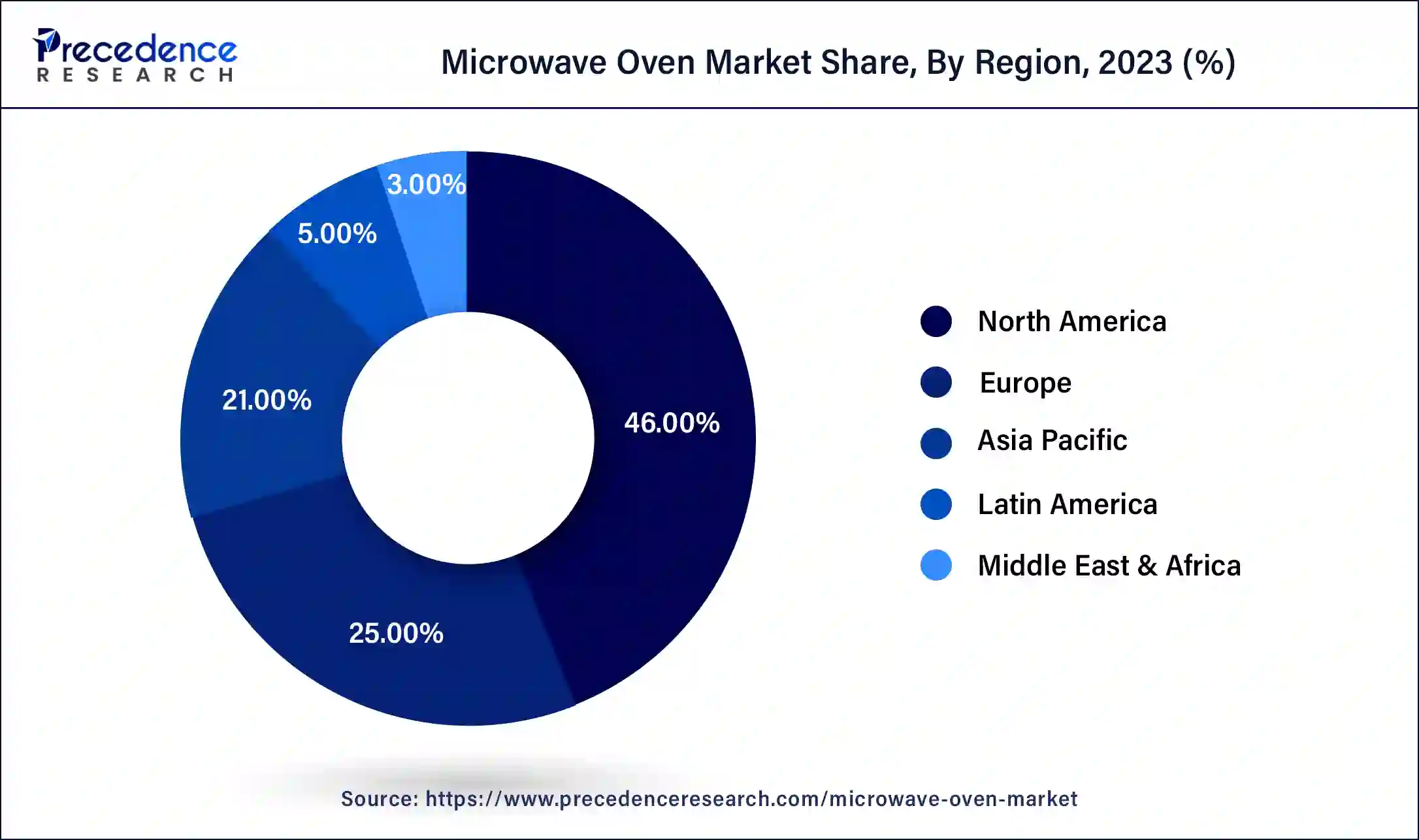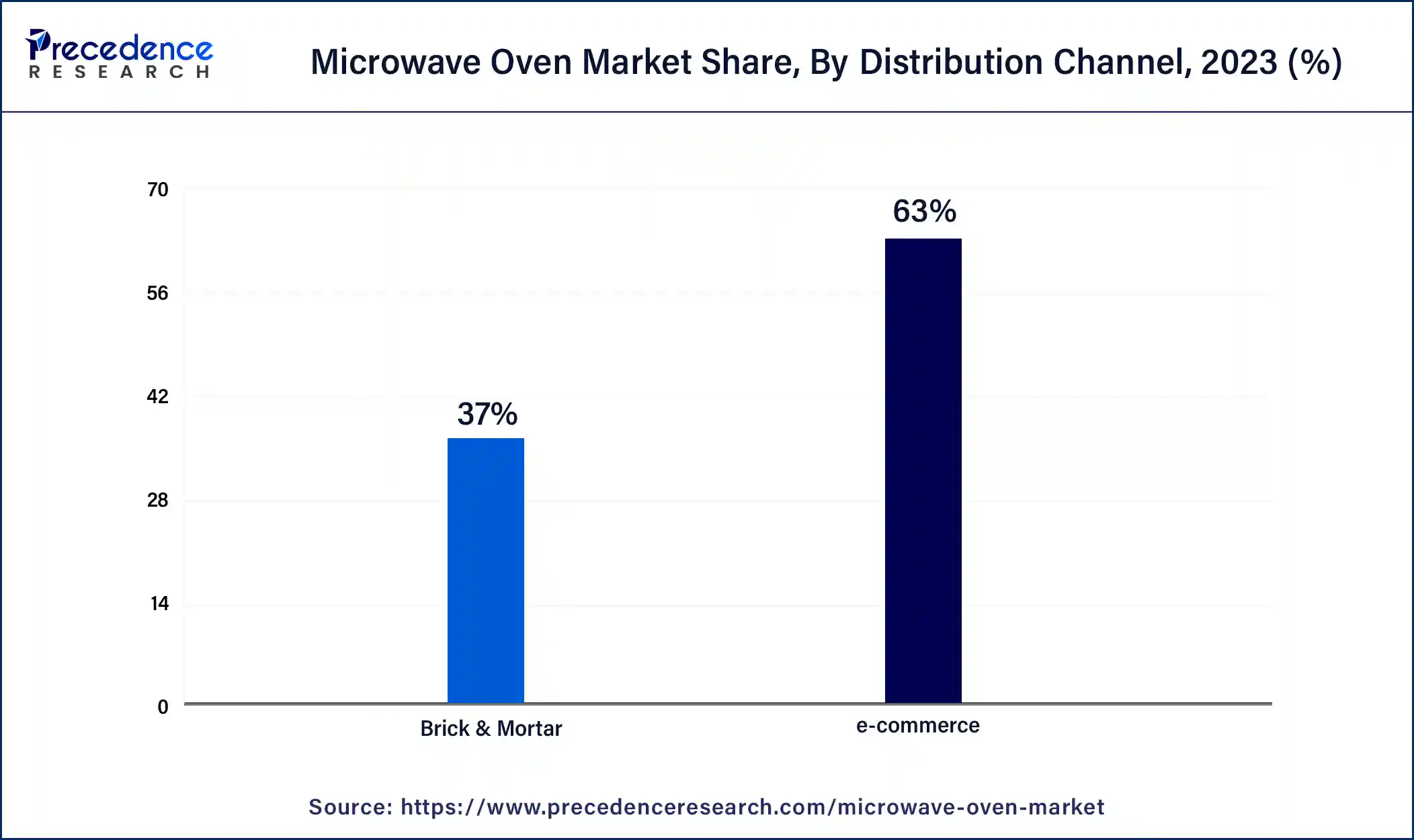The global microwave oven market size is estimated at USD 16.87 billion in 2025 and is predicted to reach around USD 24.02 billion by 2034, accelerating at a CAGR of 4% from 2025 to 2034. The North America microwave oven market size surpassed USD 7.46 billion in 2024 and is expanding at a CAGR of 4.01% during the forecast period. The market sizing and forecasts are revenue-based (USD Million/Billion), with 2024 as the base year.
The global microwave oven market size accounted at USD 16.22 billion in 2024, and is expected to reach around USD 24.02 billion by 2034, expanding at a CAGR of 4% from 2025 to 2034.

The U.S. microwave oven market size was estimated at USD 5.24 billion in 2024 and is predicted to be worth around USD 7.92 billion by 2034, at a CAGR of 4.22% from 2025 to 2034.

North America held the largest share of the microwave oven market while contributing 46% of the market share in 2024. The incorporation of advanced technologies such as smart features, inverter technology, and cooking sensors has significantly augmented the functionality and versatility of ovens in the region. These technological enhancements have contributed to making ovens more attractive to consumers. With an increasing emphasis on environmental consciousness influencing consumer purchasing decisions, manufacturers in North America are adapting by producing microwaves with energy-efficient features and materials.
Currently, North America is dominating the microwave oven market. North America holds the largest number of advanced appliance manufacturers. The basic use of a microwave oven is a popular need for the population in the region. The appliance industry is fueling the market due to the rising demand of the collective population.

Asia Pacific is poised for a robust growth rate at a CAGR of 19.5% during the forecast period. The region is currently experiencing rapid urbanization, resulting in smaller living spaces and kitchens. This shift in living trends is driving the demand for compact and space-saving appliances like ovens, which play a crucial role in quick and convenient meal preparation. Economic growth, particularly in countries such as China and India, has been accompanied by a rise in disposable income. As more households attain the financial capacity to invest in modern kitchen appliances, the demand for microwave ovens is anticipated to experience a substantial upswing in the Asia Pacific region.
The microwave oven market offers electronic devices that utilize electromagnetic waves to cook and heat food and beverage products quickly. These ovens generate microwaves, which are a form of electromagnetic radiation, to produce heat. The microwaves emitted by the oven interact with water molecules present in the food, causing them to vibrate and generate heat. This rapid heating process allows for efficient cooking and reheating of various food items. Microwave ovens have become a common kitchen appliance due to their convenience and time-saving capabilities.
The surge in the popularity of frozen food items is reshaping consumer cooking habits worldwide, with a consequential impact on the widespread adoption of rapid cooking appliances, notably microwave ovens. Frozen foods offer a compelling solution for those seeking convenience and time efficiency in meal preparation.
The rapid cooking capabilities of microwave ovens align seamlessly with the demand for quick and hassle-free cooking methods in today's fast-paced lifestyles. Consumers are drawn to the versatility of microwave ovens, which effortlessly handle a diverse range of frozen items, from complete meals to snacks. Beyond convenience, these appliances contribute to the preservation of nutritional value, a crucial consideration for health-conscious individuals.
Microwave Oven Market Data and Statistics
Technological advancements in the microwave oven market feature smart connectivity, inverter technology, and sensor-based heating. The inverter technology adjusts power levels in the cooking process. This eliminates the most concerning risk of undercooking and overcooking. The sensor-based heating detects moisture in food, elevating the taste of the food. The smart connectivity consists of wifi, a mobile app, and touch screens for monitoring the cooking process.
The modern technology contributing largely to the microwave oven market is voice recognition and application control, with popular examples Google Assistant and Alexa. This helps in pre-programming recipes, making it more reliable and convenient for the customers. The advancement is encouraging new brands and their ideas to the market.
| Report Coverage | Details |
| Market Size in 2024 | USD 16.22 Billion |
| Market Size in 2025 | USD 16.87 Billion |
| Market Size by 2034 | USD 24.02 Billion |
| Base Year | 2024 |
| Forecast Period | 2025 to 2034 |
| Segments Covered | By Product, By Structure, By Control Feature, and By Distribution Channel |
| Regions Covered | North America, Europe, Asia-Pacific, Latin America, and Middle East & Africa |
Demand for quick and efficient cooking solutions
The microwave oven market is on a robust growth trajectory driven by urbanization and the rise in the number of working individuals with hectic schedules have significantly boosted the demand for quick and efficient cooking solutions. The trend towards nuclear families, coupled with the increasing preference for frozen and ready-to-eat foods, has fueled the adoption of microwave ovens. The market is further propelled by the growth of the hospitality sector, catering contracts for large-scale events, and the surge in smart kitchen appliance sales.
As consumers seek convenience in their busy lives, the microwave oven market benefits from innovations in connectivity, inverter-based technology, and the overall increase in consumer spending on advanced kitchen appliances. The evolving lifestyles, improving standards of living, and a willingness to invest in time-saving solutions contribute to the expanding market for microwave ovens, making it a dynamic and promising industry for manufacturers.
High power consumption
Despite the significant growth in the microwave oven market, there are restraints that need to be addressed. One notable concern is the high power consumption associated with these appliances. As energy conservation becomes a global priority, consumers are increasingly conscious of the environmental impact of their household appliances.
The microwave oven market may face obstacles as consumers seek more energy-efficient alternatives, driven by a growing awareness of sustainability. This challenge highlights the need for innovation in microwave oven technology, focusing on energy efficiency and environmentally friendly practices to align with evolving consumer preferences and global efforts toward conservation. Balancing the convenience offered by microwave ovens with energy-conscious considerations will be crucial for sustained market growth.
Shifting in consumer behavior
The microwave oven market is poised to capitalize on the increasing disposable income of consumers, presenting a higher growth potential. As consumers experience a boost in their financial capacity, there is a growing inclination towards investing in smart appliances that enhance convenience in daily life. This shift in consumer behavior contributes to a rising demand for convection microwave ovens, creating more opportunities within the market.
The dynamics of the market are further influenced by changing consumer preferences and socio-economic factors, including a growing global population and the subsequent rise in disposable income. The ongoing trend of urbanization on a global scale is expected to fuel the adoption of ovens, as consumers are increasingly willing to invest in gadgets that simplify their daily household tasks. The market stands to benefit from these evolving consumer trends, marking a positive trajectory for the microwave oven industry.
The convection segment dominated the market with the majority share in the global microwave oven market while contributing 43% of the market share in 2024. Convection microwaves are equipped with a fan that circulates hot air around the food, leading to faster and more uniform cooking. This technology has gained popularity for its convenience and versatility, enabling users to perform baking, roasting, grilling, and traditional microwave functions. The increasing trend toward healthier eating habits has contributed to the appeal of convection microwaves, offering a healthier alternative to deep-frying and other high-fat cooking methods. Additionally, the compact size of these appliances makes them suitable for smaller kitchens and households. As consumers prioritize space-saving and multi-functional appliances, the demand for convection ovens is expected to continue growing.
The built-in segment dominated the microwave oven market with 69% of market share in 2024. Built-in ovens are designed to seamlessly integrate into kitchen cabinets, contributing to a sleek and stylish appearance. Additionally, they offer convenience by freeing up counter space and providing easy operation with a simple push of a button. Built-in microwaves are known for their energy efficiency, as they are incorporated into the electrical system of the kitchen.
The increasing demand for built-in microwaves can be attributed to the growing popularity of smart homes. With the advent of Internet of Things (IoT) technology, consumers are increasingly opting for appliances that can be controlled remotely or through voice commands. Built-in microwaves fall into this category, as they can be connected to a smart home system and controlled using a mobile application or virtual assistant.
The digital control feature segment took the lead in the microwave oven market while holding 56% of the market share in 2024. This segment is experiencing robust growth, driven by the increasing demand for microwaves equipped with advanced digital controls. A growing number of consumers prefer microwaves that offer sophisticated controls and settings, enabling them to cook meals with ease and speed. This trend is expected to persist in the future as technology continues to advance, and consumers integrate digital devices into their daily routines. Microwave manufacturers are responding to this demand by introducing new models with enhanced digital control features, aiming to simplify the process of food preparation.
The e-commerce segment emerged as the frontrunner in the global microwave oven market while holding 63% market share in 2024 and is anticipated to exhibit the swiftest CAGR throughout the forecast period. The preference for the convenience of shopping from the comfort of one's home and the ability to compare product features and prices across various online platforms has propelled the dominance of e-commerce.

While traditional brick-and-mortar stores offer a tactile shopping experience, online sales still constitute a substantial portion of the market. Manufacturers and retailers are strategically focusing on maintaining a robust presence in both online and physical channels to reach a broad customer base and sustain competitiveness.
Segments Covered in the Report
By Product
By Structure
By Control Feature
By Distribution Channel
By Geography
For inquiries regarding discounts, bulk purchases, or customization requests, please contact us at sales@precedenceresearch.com
No cookie-cutter, only authentic analysis – take the 1st step to become a Precedence Research client